In the preceding chapter, the variation in structure of the lingual surface of the maxil-lary incisor and its implication were discussed. Here, the problem of what position shovelling plays in the dentition as a whole is examined, and the role of shovelling is further discussed.
There are few studies on the problems of what position each dental morphological character, especially a non-metrical one, plays in the whole. As far as the present author knows, only Yamada et al. (1979) and Mizoguchi (1978) have done such studies. As mentioned above, however, the former is a study based on Cramèr's coefficient of con-tingency, so that the results may change owing to the difference in criteria for observing characters. The characters dealt with in the latter are restricted only to those within the maxillary anterior teeth, which have already been analyzed and discussed in the pre-ceding chapter.
On the other hand, studies dealing with individual relationships between non-metrical and/or metrical characters of tooth crowns are hardly scanty. For example, Dietz (1944) showed that the incidence of Carabelli's tubercle of the first molar in individuals who had central incisors with squared crowns (square type) was about twice as high as that in individuals who had central incisors with narrow necks and wide incisal edges (tapering type). Pinto-Cisternas and Figueroa (1968), Sofaer et al. (1972a), Mizoguchi (1976) and others reported that there was little or no correlation between shovelling and Cara-belli's tubercle. Sofaer et al. (1972a), in. addition, examined the relations between the cusp number and groove patterns of the molars and so forth. Suzuki and Sakai (1966) inves-tigated the association between the mesiodistal crown diameter and shovelling in each of the upper and lower anterior teeth, and stated that shovel-shaped incisors had larger mesiodistal crown diameters than incisors with no shovelling. Lombardi (1975) also showed that shovelling and Carabelli's tubercle each occurred more frequently in larger teeth. Scott (1975, 1977b) reported that there were positive associations between shovelling of the maxillary incisors and that of the mandibular incisors. Besides the above, there are many studies on the individual relations between non-metrical tooth crown characters other than shovelling.
Further, some descriptive studies on shovelling are available. Dahlberg (1951) ob-served that in American Indians the frequency of shovelling was high and, at the same time, the frequency of maxillary molars with the hypocone extremely reduced was also high. In the report by Moorrees (1957), it was stated that in Aleuts shovelling and the bicuspid mandibular lower second premolars were frequently present but Carabelli's tubercle was rare.
The above all seem to suggest that shovelling has played a role in the history of human adaptation through dentition. In this chapter, the position of shovelling in the complex
interrelationships between various tooth crown characters of the permanent teeth is inferred through principal component analyses. Based on these results and previous studies, the significance of the existence of shovelling is further considered.
3.1. Materials and Methods
The materials used here are the same as those in the preceding chapter (Table 1). The procedure of analyses and the statistical analysis methods are again the same as those in the preceding chapter. The tooth crown characters dealt with here are as follows.
Shovelling (UI1, UI2): the criterion for classification of this character has already been stated.
De Terra's tubercle (UP1, UP2), Carabelli's tubercle (UM1), reduced hypocone (UM1), lingual accessory cusp (LP1, LP2), protostylid (LM1), sixth cusp (LM1), seventh cusp (LM1) and reduced hypoconulid (LM1): the criteria for classification of these non-metrical characters were all according to Mizoguchi (1977b).
Reduced lingual cusp (UP1, UP2): the criterion, for classification was defined as follows.
0: The height of the lingual cusp is nearly the same as that of the buccal cusp.
1: The lingual cusp is clearly lower in height than the buccal cusp.
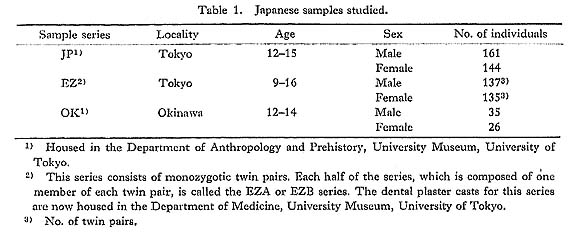
Besides the non-metrical characters above, the mesiodistal crown diameters of the permanent teeth from the central incisors to the first molars in both jaws, which were measured using the method of Fujita (1949), were included in the succeeding analyses.
The method of calculation is the same as that in the preceding chapter.
3.2. Results
3.2.1. Sex Differences and Between-sample Differences
Two independent samples were used to assess the repeatability of results, as in the preceding chapter. The incidence of each non-metrical tooth crown character and its sex difference are shown in Table 22, and the results of the significance tests for the
between-sample differences are in Table 23. The results for shovelling, however, are shown in Tables 2 and 5. The sex differences in mesiodistal crown diameters are in Table 7, and the between-sample differences in Table 8.
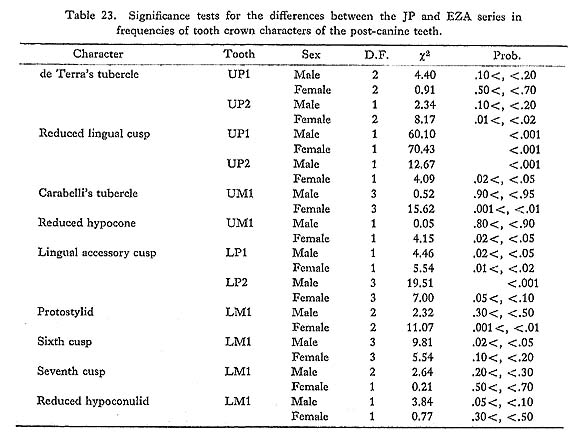
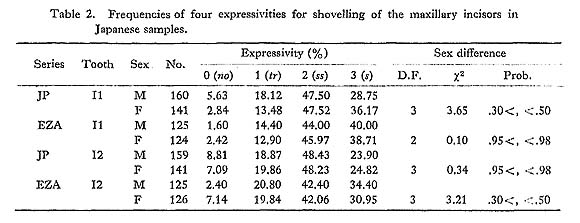
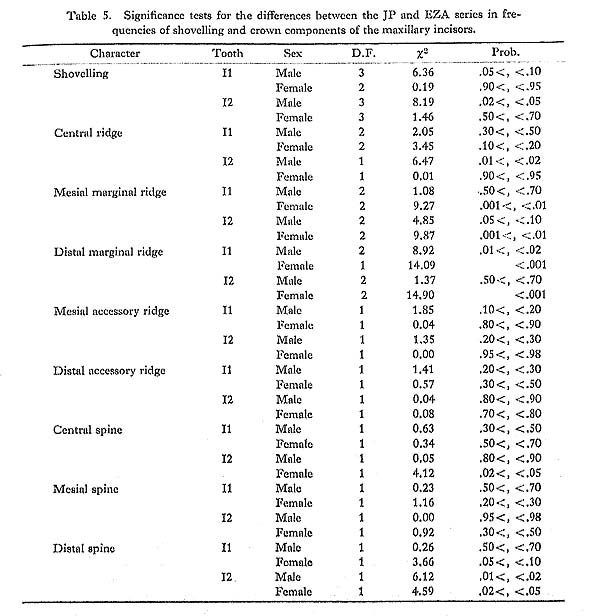

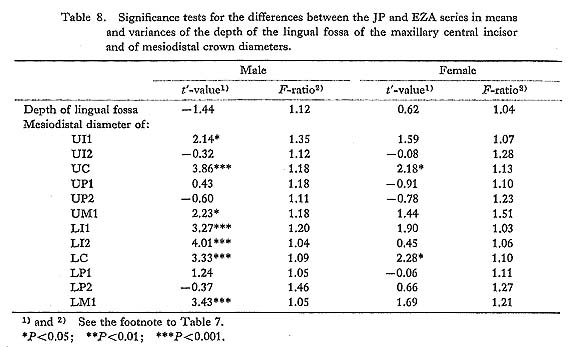
It is clear from these tables that there is no significant sex difference at the 5% level in the incidence of shovelling of the central incisors or of the laterals. As regards the between-sample difference in shovelling, a significant difference was found only in the case of the male lateral incisor.
Of the non-metrical characters in the posterior teeth, five, i.e., Carabelli's tubercle (JP, EZA), the lingual accessory cusp of the mandibular first premolar (JP), the proto-stylid (JP), the sixth cusp (JP) and the seventh cusp (JP) had significant sex differences in incidence at the 5% level. Significant between-sample differences were recognized in nine of the twelve non-metrical characters in the posterior teeth, where one or both of the sexes showed such differences (Table 23).
With respect to means of mesiodistal crown diameters, significant sex differences (5% level) were recognized in almost all the teeth examined (Table 7). However, there was no significant sex difference (5% level) in variance in any of the teeth. Significant between-sample differences (5% level) were restricted to the mean values in seven of the twelve teeth for males and in two for females. Particularly, the upper and lower canines showed significant between-sample differences both in males and in females (Table 8).
3.2.2. Phenotypic Correlations and Genetic Correlations
As in the case of the analyses in the preceding chapter, the phenotypic correlation matrices of the male and female JP and EZ series and the genetic correlation matrices based on the EZ series were calculated. However, de Terra's tubercle and the reduced lingual cusp of the maxillary second premolar, the lingual accessory cusp of the mandibular first premolar and the seventh cusp were excluded from the analyses because their incidence was too low or too high to calculate the relevant tetrachoric correlation coefficients.
First of all, intraclass correlation coefficients within monozygotic twin pairs, necessary for estimating genetic correlations, were calculated for the individual characters. They are shown in Table 9 for shovelling, in Table 24 for the other non-metrical characters, and in Table 11 for mesiodistal crown diameters. These tables indicate that in nine of the ten non-metrical characters the intraclass correlation coefficients tend to be higher in females than in males. Although these differences may not be significant, it seems likely that male tooth crown characters generally have higher environmental relative varia-bility, or higher genetic relative stability than female tooth crown characters. However, this interpretation may be restricted to the case where an intraclass correlation coeffi-cient within monozygotic twin pairs is regarded as a heritability estimate.
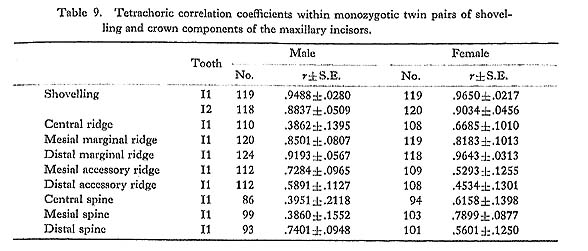
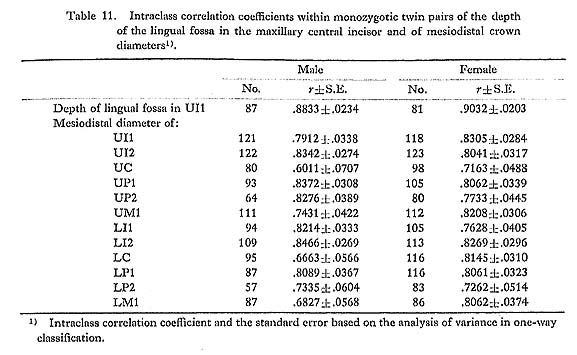
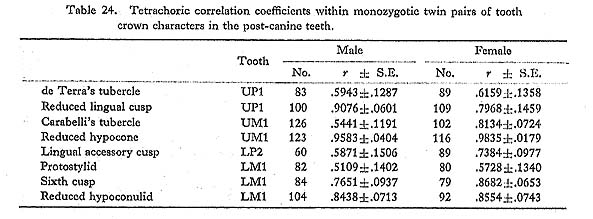
In order to assess the reliability of intraclass correlation coefficients for non-metrical characters, the discordance frequencies within twin pairs were compared with those between double observations of the same subjects (Tables 10 and 25). Through these comparisons, significant discordance within twin pairs (5% level) was found in only three characters, i.e., de Terra's tubercle (male and female UP1), the lingual accessory cusp (male LP2) and the protostylid (male and female LM1). Of the other seven char-acters, discordances within twin pairs were not significantly different from the error discordances, so that the relevant intraclass correlation coefficients are, in fact, inferred to be closer to one.

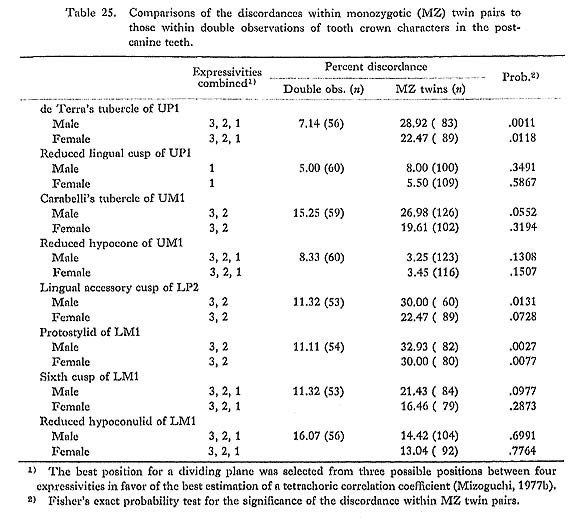
The reliability of the intraclass correlation coefficients for the mesiodistal crown diameters was assessed by comparing the mean intrapair variances within twin pairs to the mean measurement error variances (Table 12). The result was that the mean intra-pair variances within twin pairs were significantly (5% level) greater than the error variances in all the teeth examined. This implies that the errors are small and, therefore, the intraclass correlation coefficients estimated within twin pairs are highly reliable.

In Tables 26 and 27, the phenotypic correlation matrices for the JP and EZ series are shown. The genetic correlation matrices are in Table 28. Focusing on the correlation coefficients of shovelling only, at least two points may be noted. One is that shovelling of the central or lateral incisor did not have such a high phenotypic correlation with the other non-metrical characters. Throughout the four matrices for the male and female JP and EZ sereis, the maximum absolute values of such correlation coefficients were between 0.20 and 0.40. The other point is that, if two of the largest among the absolute values of the correlation coefficients between shovelling and mesiodistal diameters were picked from each of the four correlation matrices, teeth of which the mesiodistal diameters were most highly correlated with shovelling of the maxillary central incisor were the maxillary central and mandibular lateral incisors in three of the four matrices. In the case of shovelling of the maxillary lateral incisor, one of two such teeth was the maxillary lateral incisor also in three of the four matrices. In short, shovelling tended to have the highest correlations with the mesiodistal diameters of the teeth to which the shovelling belonged. This trend was also recognized in the case of the genetic correlation matrices.

Table 26. Phenotypic correlation matrices of tooth crown characters in the permanent teeth of males (upper right half) and of females (lower left half) in the JP series1). |
The correlation between shovelling of the maxillary central incisor and of the lateral incisor was high, as was expected. The phenotypic correlation varied between 0.59 and 0.94 in males and between 0.72 and 0.77 in females, in addition to a genetic correlation of 0.63 in males and 0.82 in females. Incidentally, the correlation between shovelling and Carabelli's tubercle was very low in all the matrices, not exceeding the range of-0.15 to 0.15.
3.2.3. Factor Structure in the Dentition
In the preceding section, no clear direct interrelationship was recognized between shovelling and other non-metrical characters. Here the results of the principal component analyses for these interrelationships are described. The results for the phenotypic cor-relations of the JP and EZ males and females are shown in Tables 29 to 32, and those for the genetic correlations in Tables 33 and 34. Common to almost all these analyses are, first, that the first principal component is explicitly related to the mesiodistal crown diameters of all the teeth dealt with, and, second, that the second principal component is highly related to shovelling and other characters. As the first principal component was also slightly correlated with shovelling in some cases, these two principal components were examined in more depth. The contribution, with the sign of factor loading, of the first principal component to each character is illustrated in Figs. 4 to 6, and that of the second principal component in Figs. 7 to 9.
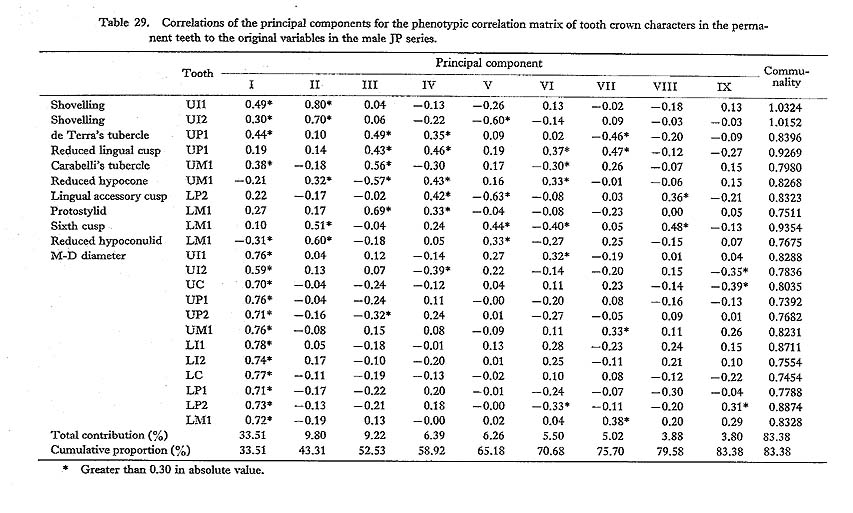
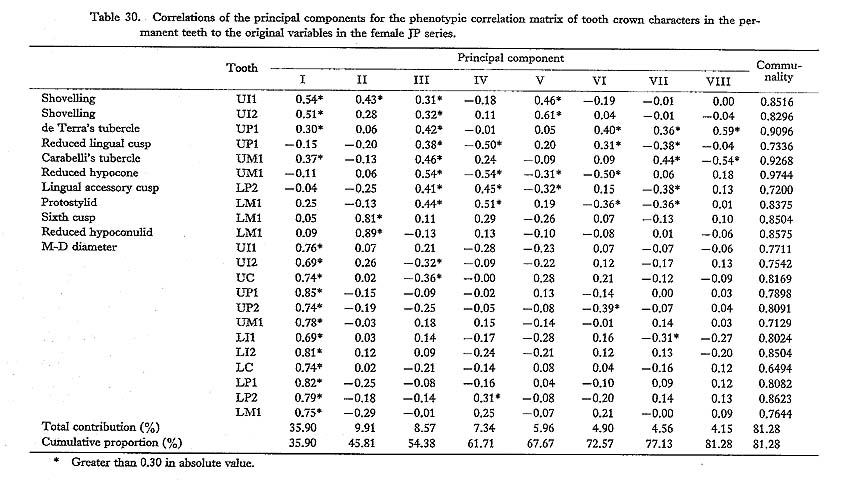
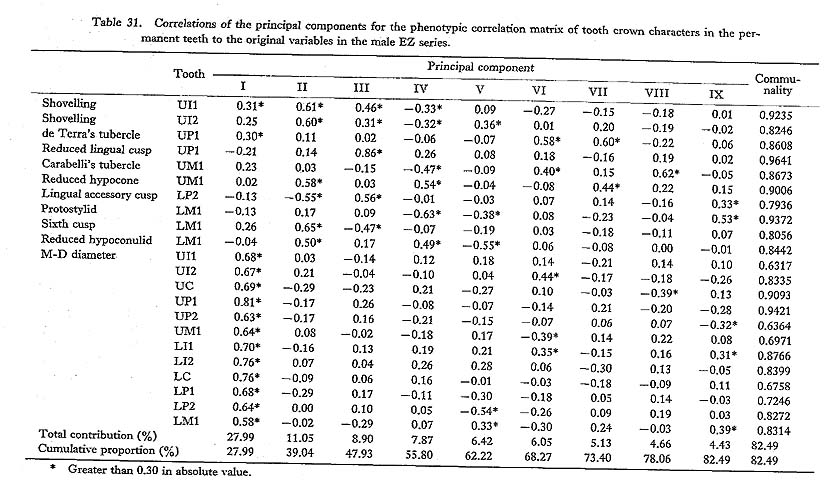
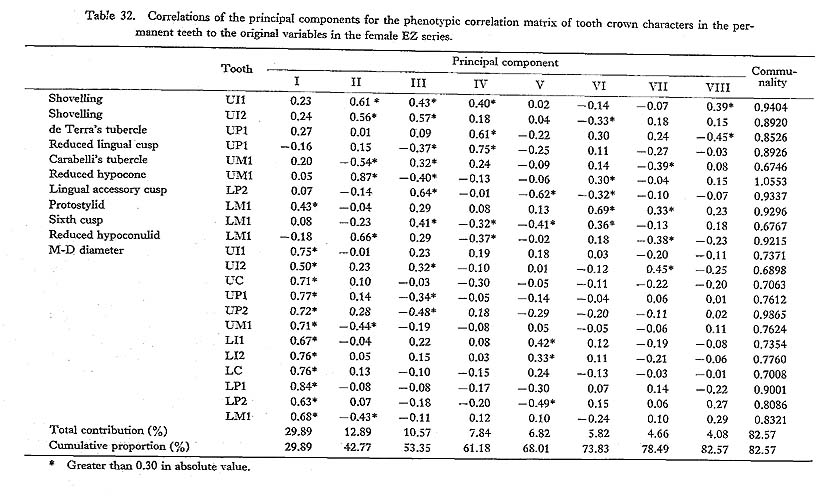
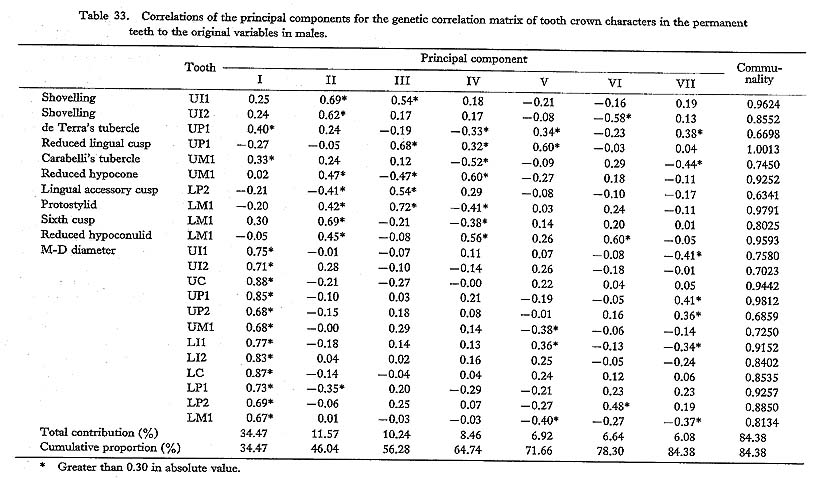
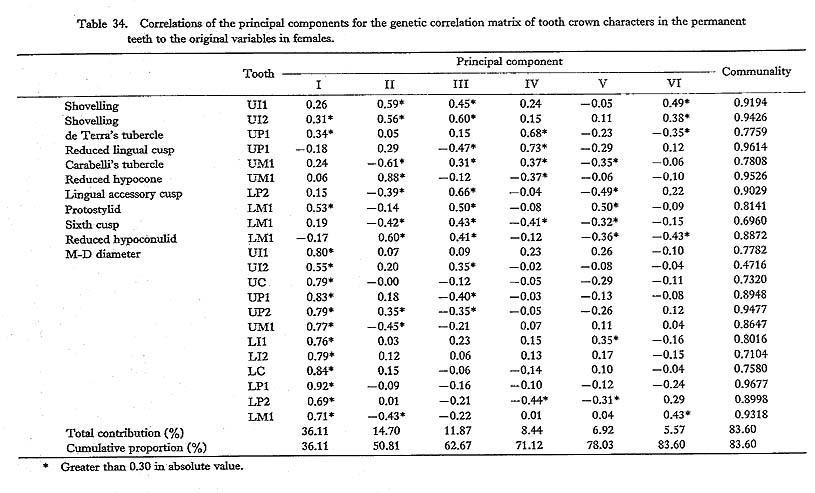
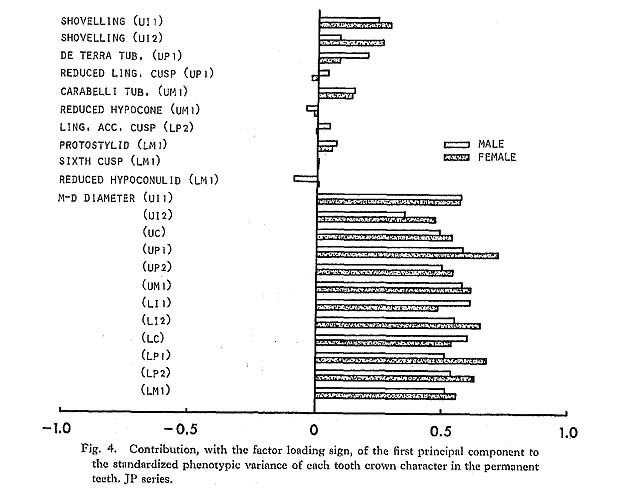

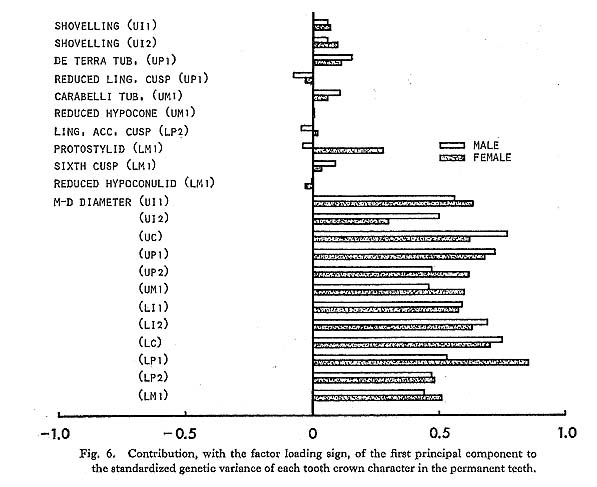
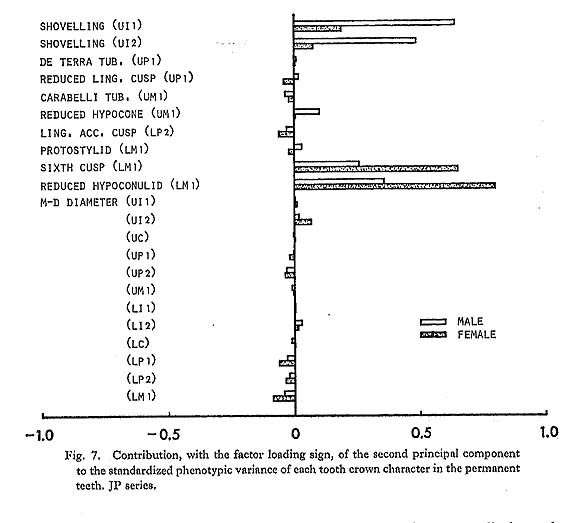
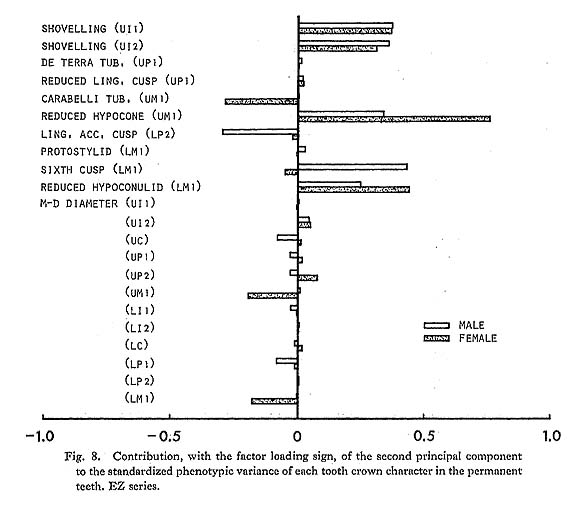

The first principal component for the phenotypic correlations of the JP series (Fig. 4) had strong correlations to the mesiodistal diameters of all the teeth, simultaneously rela-tively high correlations with the same sign to shovelling and further, though slightly less in degree, to Carabelli's tubercle. This first principal component also tended to have a considerable correlation with the same sign as the above to de Terra's tubercle, though such a tendency was a little different between males and females. Again in the EZ series (Fig. 5), the same tendency as that in the JP series was recognized, but not so clearly. In this case, the first principal component had a somewhat high correlation with the proto-stylid (only in females) in addition to a high correlation with the mesiodistal diameters. The pattern which was observed in the results for the phenotypic correlations of the EZ series appears to be emphasized in the results for the genetic correlations (Fig. 6), though the pattern found in the JP series is also slightly discernible in them.
The contribution of the second principal component to the original characters is very interesting. Common to the male and female JP series (Fig. 7) was that this principal component had high positive correlations with shovelling of the central and lateral incisors, the sixth cusp and the reduced hypoconulid, though differences in degree were found between males and females, and further tended to have a slight correlation with the same sign as the above to the reduced hypocone. This pattern of contribution is repeated exactly in the case of the male EZ series (Fig. 8), where the correlation to the reduced hypocone was higher than in the JP series, and, additionally, this component had a correlation with the opposite sign to the above to the lingual accessory cusp of the mandibular second premolar. In the female EZ series, the result was somewhat different. Namely, the negative correlations to Carabelli's tubercle as well as to the mesiodistal crown diameters of the maxillary and mandibular first molars are added to the features of the male EZ series instead of the correlation to the sixth cusp disappearing. These patterns m the male and female EZ series again occur in the results for the genetic correlations (Fig. 9).
Summarizing the above, it is clear that the first principal component, which is highly correlated with the mesiodistal diameters of all the teeth, also has a tendency to be correlated with shovelling to some extent, and that the second principal component which is profoundly related to shovelling always has a high correlation at least with the reduced hypoconulid.
These direct solutions of the principal component analyses were further transformed by the normal varimax rotation method in order to view them from another standpoint. As a result, as shown in Tables 35 to 40, the factor common only to shovelling of the maxillary central and lateral incisors was extracted in all the cases. The results of the transformation for the genetic correlations were almost consistent with those for the phenotypic correlations of the EZ series. Therefore, only the results for the phenotypic correlations will be further explained. There were three other major factors which were independent of the above factor. They were found in at least three of the four principal component analyses in the same way: the factor on the mesiodistal diameters of the upper and lower posterior teeth, especially of the premolars, the factor on the mesiodistal diameters of the upper and lower anterior teeth, especially of the incisors, and the factor on the mesiodistal diameters of the upper and lower molars as well as the hypocone or hypoconulid. These suggest a possibility that shovelling may vary independently of the sizes of the anterior and/or posterior teeth.
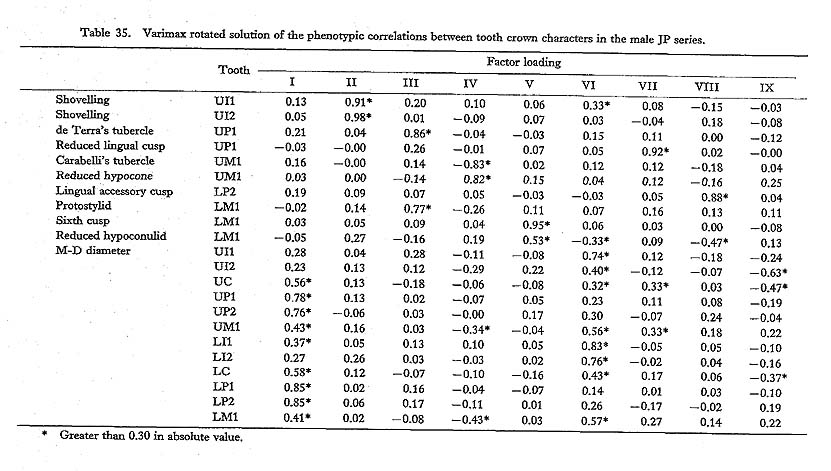

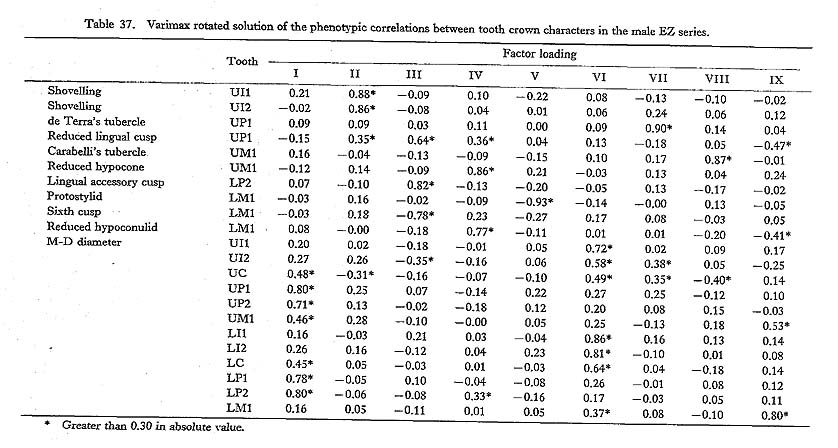
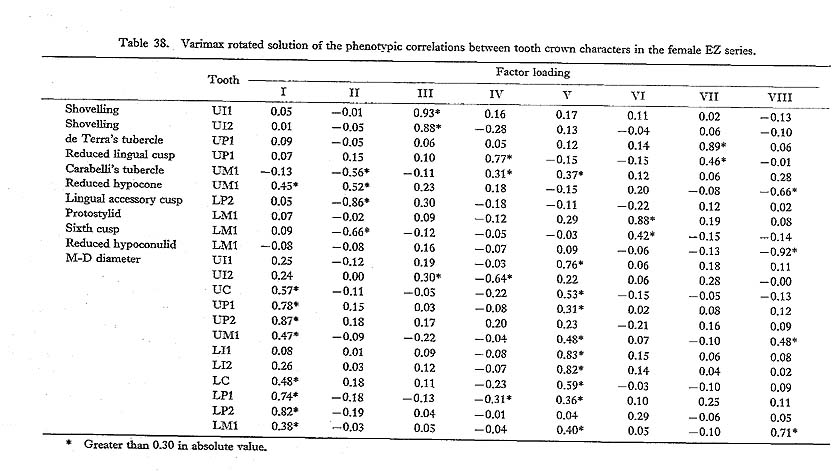

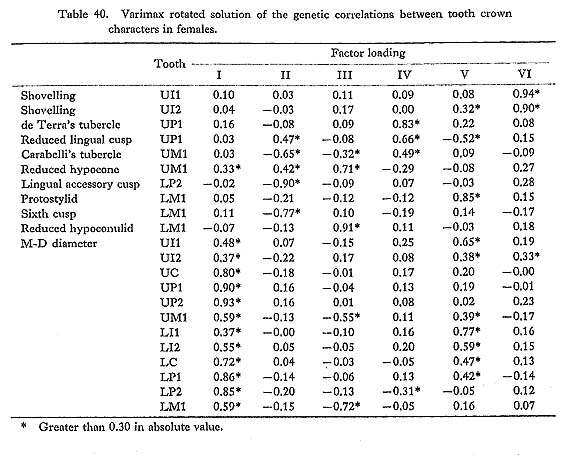
3.3. Discussion
In the preceding section, it was clarified by principal component analysis that there were some common interrelationships between dental characters of the two samples which had different incidences or means for several characters. However, there is the problem of which of the solutions, that obtained directly from principal component analysis or rotated based on a model for factor analysis, is more useful to determine the implication of shovelling. In order to analyze actual and complicated phenomena, no analysis method is of any use unless some biological meaning can be imposed upon it. Here, the rotated solution will be left for future discussion because it is difficult to impose an appropriate biological meaning on such a method of rotation at the present. Therefore, only the former solution is discussed below.
The direct solution of principal component analysis can be obtained simply by determining the first axis as the direction with the greatest variation in the whole of a complex of characters in question and, next, the second axis as the direction, perpendicular to the first axis, with the greatest variation in the remains of the whole excluding that of the first axis, and so on. If a set of characters occurs in the system of an organism as an adaptive response to a given environment and cooperatively accomplishes a certain function in their interrelationship, a certain tendency common to them ought to be recognized in their variation. When the greatest of the variations common to them can be assumed to be adaptively most important (Mizoguchi, 1981), the direct solution of principal component analysis may be interpreted as such.
The first principal component obtained here indicated that the mesiodistal diameters of all the teeth examined are more or less correlated with shovelling. This is not incom patible with the results of the analyses for the central incisor in the preceding chapter or with the studies by Suzuki and Sakai (1966), Lombardi (1975), Mizoguchi (1978) and others.
The second principal component suggested that shovelling and the reduced hypoconulid or hypocone varied in the same direction. In the present study, the reduced form of the hypoconulid or hypocone was regarded as a character. But, if the developed
forms were analyzed as in the case of shovelling, shovelling and the developed forms of these distal cusps would have some correlation with opposite signs to the second principal component. In such a case, the two groups of original characters might have a compensatory interrelation or vary independently of one another (Mizoguchi, 1981). Therefore, when the developed forms of the distal cusps are considered as the variables to be analyzed, it is unknown whether the hypoconulid and hypocone vary in compensation for or independently of shovelling. However, there is no doubt that the variation of these characters can be almost independent of that of the size of the whole dentition. The phenomenon of a whole tooth crown reducing is not necessarily equivalent to the phenomenon of one part, such as a cusp, reducing. That is, there is a portion of variation which is independent of the variation of the whole dentition, in both shovelling and the distal cusps of the molars. Furthermore, what is called the size of the distal cusps dealt with here is the relative size which is determined through comparison with the sizes of the other cusps within the same crown. It seems rather natural, therefore, that the hypocone, the hypoconulid or the other non-metrical characters expressed by relative size had no correlation with the first principal component.
Before the interrelations between the development of shovelling and the reduction of the distal cusps in the molars are further discussed, the direct relationships of shovelling with other characters will here be discussed.
First, Scott (1975, 1977b) showed that there were some associations between shovelling of the upper incisors and that of the lower ones. This seems reasonable if the maxillary and mandibular incisors each play a role in the same function.
It is almost certain that there is no superficial correlation between shovelling and Carabelli's tubercle (Pinto-Cisternas and Figueroa, 1968; Sofaer et al., 1972a; Mizoguchi, 1976). This was again confirmed in the present study (Tables 26 to 28). Although the second principal component for the phenotypic correlations of the female EZ series had correlations with the opposite sign to shovelling and Carabelli's tubercle, respectively (Table 32), those principal components which were most highly correlated to Carabelli's tubercle in the other three cases (Tables 29 to 31) had very little correlation to shovelling. The above relationship in the EZ females can also be found even when two such characters vary independently of one another. Therefore, it is most likely that shovelling and Carabelli's tubercle can occur in the anterior and posterior teeth, respectively, independently of one another.
It has been stated that shovel-shaped incisors tend to be larger than incisors with no shovelling (Suzuki and Sakai, 1966; Lombardi, 1975; Mizoguchi, 1978). This was indicated both in the results of the analyses on the central incisor in the preceding chapter and in the results in the present chapter. However, the correlation between shovelling and tooth size is not so high, in fact most of the variation in shovelling is independent of variation in the mesiodistal diameters, as shown clearly by the principal component analyses in the present study. As regards the relation between shovelling and mesiodistal crown diameters, Lombardi (1975) stated that shovelling was in substance a lingual ward extension of the marginal ridges, and the fact that shovel-shaped incisors had large mesiodistal crown diameters was not necessarily inconsistent with Brace's hypothesis that shovelling increases the size of the incisors in such a way that the mesiodistal diameter of the incisor and the space it occupies in the dentition are not increased appreciably. In Brace's hypothesis, however, the development of shovelling seems to be interpreted as compensation for the size of the mesiodistal diameters of the incisors. If so, the present author fails to agree with Brace's hypothesis because shovelling seems to be a structure for some other functions, i.e., probably for resisting the force pulling the teeth forward, as was mentioned in the preceding chapter.
Now let us return to the relations between shovelling and the distal cusps of the molars. Sofaer et al. (1972a), probably using the four-fold point correlation coefficient,
estimated the associations between these characters. The cusp numbers of the maxillary second and third molars, as well as those of the mandibular first and second molars, had no significant association with shovelling of the maxillary central incisor at the 5% level, but the cusp numbers of the mandibular first and second molars had some significant association with shovelling of the maxillary lateral incisor. However, the coefficients of the latter two associations were as low as 0.16 and 0.18, respectively. These are not inconsistent with the present results (Tables 26 and 27).
Dahlberg (1951) reported on morphological features of the teeth of American Indians: the tooth size was large; shovelling was highly developed; the frequencies of three-cusped maxillary second and third molars were high but, at the same time, those of five-cusped mandibular second and third molars with the + pattern were also high; and Carabelli's tubercle was less frequent and, if present, small, Moorrees (1957) stated, with respect to Aleut dentition, that shovelling was very well developed; Carabelli's tubercle was almost absent; and mandibular molars with the + pattern were very frequent while four-cusped maxillary second molars and five-cusped mandibular second and third molars were frequent. These two reports are very interesting. Notwithstanding the fact that both American Indians and Aleuts have highly-developed shovelling, the reduction of the hypocone is remarkable in the former but not in the latter. This fact seems evidence for shovelling and the distal cusps of the molars varying independently of one another, and, if so, is consistent with the present results (Tables 26 and 27). After all, the second principal component extracted here seems to show merely that shovelling is basically independent of, and not a compensation for, the hypoconulid or hypocone.
The independence in variation of the anterior and the posterior teeth is evident from the fact, shown by Brace (1979), that Australian aborigines and Neanderthals who have posterior teeth of nearly the same size have anterior teeth of completely different size, i.e., the anterior teeth with well-developed shovelling of Neanderthals were much larger than the anterior teeth of Australian aborigines. Hanihara (1977) carried out principal component analysis of the mesiodistal crown diameters on the basis of samples from six world populations such as Australian aborigines, Japanese, American Negroes, etc. His results showed that the second principal component had factor loadings with opposite signs for the anterior teeth and for the posterior ones; that is, among these six populations there were those who had larger anterior teeth and smaller posterior teeth, and vice versa. Moreover, Mizoguchi (1981) suggested, based on a canonical correlation analysis of mesiodistal crown diameters, that the anterior and posterior teeth, respectively, made a "variation unit" which varied independently.
In addition, the fact that agenesis of the maxillary lateral incisors is less frequent in Chinese than in American whites and Negroes (Schultz, 1932) and that agenesis of the third molars is more frequent in Mongoloids than in other populations (Dahlberg, 1963a) suggests that Mongoloids are more heavily dependent upon the anterior teeth in their lives than other populations.
Taking all the above into account, it is most likely that the overall size or shovelling of anterior teeth and the overall size or distal cusps of posterior teeth can change in response to some adaptive demands independently of one another in addition to variation in the dentition as a whole.
3.4. Summary
Based on two different samples, the interrelationships between tooth crown characters in the overall dentition were analyzed by the principal component analysis method to examine what position shovelling maintained in the greater whole.
It became clear that the first principal component had high correlations with the mesiodistal crown diameters of all the teeth examined and also, to some extent, with shovelling and some other characters, and that the second principal component was related particularly to shovelling as well as the hypoconulid of the mandibular first molar and the hypocone of the maxillary first molar.
By taking account of these results in conjunction with the reports by previous authors, it was concluded that shovelling of anterior teeth and the distal cusps of posterior teeth could vary in response to each adaptive demand independently of one another in addition to overall variations in the teeth.